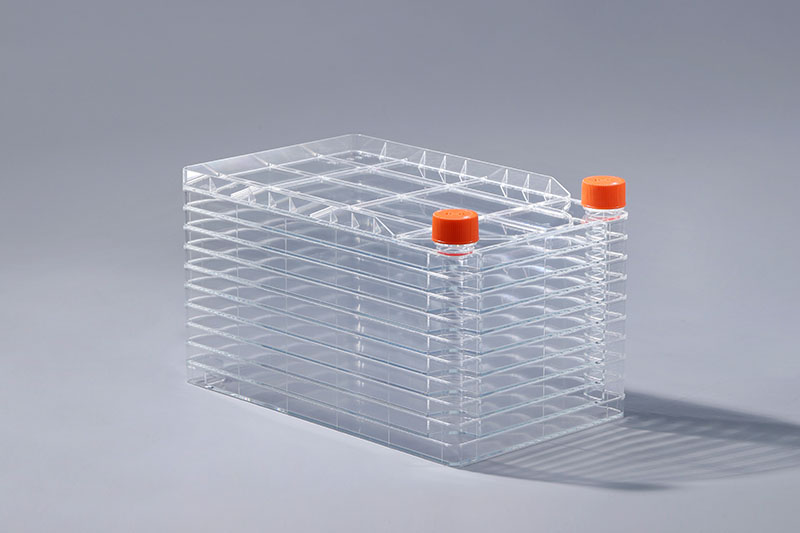Bir Özetlemek gerekirse, ozmotik basınç hücrelerin normal büyümesini doğrudan etkiler. Hücreleri yetiştirmek için hücre fabrikasını kullanırken, hücrelerin iyi büyümesini sağlamak için hücrelerin koşullarına göre uygun bir ozmotik basıncı korumak gerekir. kullanılarak hücreler kültürlenirken, çeşitli faktörlere karşı hassastır. Ozmotik basıncın da çok önemli bir yönü olduğu sıcaklık, PH değeri, gaz ortamı vb. Bu nedenle ozmotik basınç, hücrelerin in vitro kültürlenmesi için önemli koşullardan biridir. Memeli ve diğer hayvan doku hücrelerinin in vitro ozmotik basıncının korunması esas olarak NaCl ile ilgilidir, ancak diğer dielektriklerin ozmotik basınç ilişkisi göz ardı edilemez. Ozmotik basınç, birim hacim çözücü başına çözünen maddenin molekül ve iyon sayısı ile orantılıdır. Bu nedenle kültür ortamındaki iyon dengesinin belirli bir oranda kontrol edilmesi ve normal ozmotik basıncın korunması çok önemlidir. Bu sadece hücre gerilimini korumak için değil, aynı zamanda hücrelerin metabolizmasını düzenlemek için de geçerlidir. Hücre dışı iyon taşınması ve iyon konsantrasyonu diğer besin maddelerinin (amino asitler, sakaroz vb.) taşınmasını değiştirdiğinden, hücrelerin temel sentez sistemini doğrudan etkiler. hücre tipi ve ırkı. İnsan plazmasının ozmotik basıncı, insan hücrelerinin in vitro kültürlenmesi için ideal ozmotik basınç olarak kabul edilen 290 mmol/L'dir. Memeli hücrelerinin ozmotik basıncı genellikle 290 ila 300 mmol/L'dir. İnsan embriyonik akciğer fibroblastları 250-325 mmol/L'dir ve fareler yaklaşık 310 mmol/L'dir. Pratik uygulamalarda, 260-320 mmol/L'lik ozmotik basınç çoğu hücre için uygundur.
Cells in hypertonic or hypotonic solutions can shrink or swell and rupture immediately. Therefore, osmotic pressure is one of the important conditions for culturing cells in vitro. The maintenance of osmotic pressure of mammalian and other animal tissue cells in vitro is mainly related to NaCl, but the relationship of osmotic pressure of other dielectrics cannot be ignored. The osmotic pressure is proportional to the number of molecules and ions of the solute per unit volume of solvent. For this reason, it is very important to control the ion balance in the culture medium in a certain proportion and maintain normal osmotic pressure. This is not only to maintain cell tension, but also to regulate the metabolism of cells. Because extracellular ion transport and ion concentration change the transport of other nutrients (such as amino acids, sucrose, etc.), it directly affects the basic synthesis system of cells.
The ideal osmotic pressure of cell factory cultured cells varies with the type and race of cells. The osmotic pressure of human plasma is 290 mmol/L, which is considered to be the ideal osmotic pressure for culturing human cells in vitro. The osmotic pressure of mammalian cells is generally 290 to 300 mmol/L. Human embryonic lung fibroblasts are 250-325 mmol/L, and mice are about 310 mmol/L. In practical applications, the osmotic pressure of 260-320 mmol/L is suitable for most cells.
To sum up, the osmotic pressure directly affects the normal growth of cells. When using the cell factory to cultivate cells, it is necessary to maintain an appropriate osmotic pressure according to the conditions of the cells, so as to ensure the good growth of the cells.
The FAI climbed 5.9 percent year-on-year in the first 11 months of 2018, quickening from the 5.7-percent growth in Jan-Oct, the National Bureau of Statistics (NBS) said Friday in an online statement.
The key indicator of investment, dubbed a major growth driver, hit the bottom in August and has since started to rebound steadily.
In the face of emerging economic challenges home and abroad, China has stepped up efforts to stabilize investment, in particular rolling out measures to motivate private investors and channel funds into infrastructure.
Friday's data showed private investment, accounting for more than 60 percent of the total FAI, expanded by a brisk 8.7 percent.
NBS spokesperson Mao Shengyong said funds into weak economic links registered rapid increases as investment in environmental protection and agriculture jumped 42 percent and 12.5 percent respectively, much faster than the average.
In breakdown, investment in high-tech and equipment manufacturing remained vigorous with 16.1-percent and 11.6-percent increases respectively in the first 11 months. Infrastructure investment gained 3.7 percent, staying flat. Investment in property development rose 9.7 percent, also unchanged.
 English
English



















































